A thread on the Fishing Magic forum has made reference to an article I wrote a little while ago so I thought it might help if I published it again. I can’t for the life of me lay my hands on the original pictures and my limited web design skills mean that I’m unable to embed the charts into the text in a friendly manner but I’ve done my best to show the data. Just remember to consider the colour coding as this tells you whether each set of scales delivered a low, high or accurate reading.
What this simple test clearly showed was that none of the scales were truly accurate and that they could be correct in, say, the 6lb band whilst being inaccurate at 2lb or 10lb. In other words, none of the scales we checked were 100 per cent accurate…
Weighty Matters – The Scales Of Justice
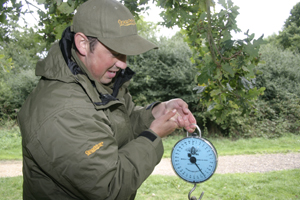 How many times have you picked up an angling newspaper and shook your head at the catch pictures: ‘Joe Bloggs (39), a window cleaner from Trumpton, is over the moon after catching his first ever pike. The 28lb leviathan snapped up a small spoon and is thought to be the same fish that has terrorised the local park lake for some time. “It has eaten at least five ducks and recently attacked a small German Shepherd!” said Joe, who is planning to have his trophy mounted.
How many times have you picked up an angling newspaper and shook your head at the catch pictures: ‘Joe Bloggs (39), a window cleaner from Trumpton, is over the moon after catching his first ever pike. The 28lb leviathan snapped up a small spoon and is thought to be the same fish that has terrorised the local park lake for some time. “It has eaten at least five ducks and recently attacked a small German Shepherd!” said Joe, who is planning to have his trophy mounted.
Of course the fish in the picture weighs no more than half the claimed weight.
Sound familiar? Of course it does. Does it matter? That depends upon the individual but I know I get really wound up when I see ridiculous weights claimed for fish that come from waters I fish.
Do you ever go in a tackle shop and some guy says, “You’re going chub fishing? If I were you I’d get down to the Don. Old Fred had five great lumps on Thursday. Reckon they must have been well over six pounds and he lost one even bigger, 7lb if it were an ounce!”
“Yer what, you’ve never had one over four and a half pounds from there? Tha’ must be useless, kid!”
It makes my blood boil.
And we’re bombarded by the kind of headlines that read, ‘Dave Lane Catches His Fifth Fifty’, ‘Traveller Tops Twenty’, ‘River Records Tumble’, “How to Catch Your First Thirty”, etc, etc.
Angling has a numbers obsession. We’re statistical nuts – record weights, individual river and lake records, brace records, personal bests, Nev’s big pike list, 3, 4, 5 and 6-hour match records, and on it goes.
Don’t tell me it doesn’t matter, either. I carried a Little Sampson spring balance when I was still in short trousers. Today I see idiots weighing every single barbel they catch from the Trent, even piddling 6-pounders, as though it’s a matter of life or death. One friend carries a mini tape recorder, another keys weights into his mobile phone. A mate was carp fishing on a virgin water this week and he rang to say he’d resorted to writing down the weights on a scrap of paper because he’d had so many – five twenties and umpteen big doubles.
Everyone’s at it. It’s crazy! How many fish do we really need to weigh? I wouldn’t mind so much if there wasn’t a massive flaw underpinning the whole process. Most of the portable scales used by anglers are inaccurate.
Take mine. I’ve had suspicions that my regular scales are faulty for a while but as they seemed to weigh under rather than over it didn’t trouble me too much. I rarely faff about with the odd ounces except on small fish like roach and perch. With barbel and carp, if I weigh a fish and it isn’t a PB I’ll happily round the weights down to the quarter pound below rather than mess about waiting for hovering pointers to settle.
I no longer bother weighing Trent barbel now unless they look to be well over 10lb but I have to confess the claims by some anglers have caused me deep concern. All too often I read claims by anglers that the number of doubles they catch averages out at something like one fish in ten whereas my own average has been nearer one in thirty.
Clearly I’m crap.
Matt Brown, who takes a lot of my pictures, is a very good angler. He put in a massive amount of effort to catch his first Trent double, his batting average worked out at something like a hundred fish before he nailed a double. It simply doesn’t add up, does it?
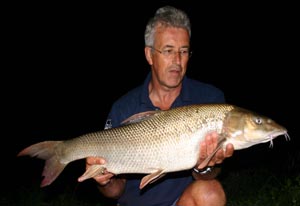 On one busy night two seasons ago I weighed five of the barbel I caught. They averaged 9lb 12oz yet not one was a double. The night I had my biggest ever barbel from the Trent I was fishing alone but there were a couple of lads ‘guesting’ about thirty yards above me. They hadn’t a clue that I’d landed the big girl but my dilemma was what to do about getting a good photograph. I’m crap at self-takers, in daylight never mind in the dark, but I didn’t want to advertise the fact that I’d had such a big fish because it would inevitable encourage more ‘guesting’.
On one busy night two seasons ago I weighed five of the barbel I caught. They averaged 9lb 12oz yet not one was a double. The night I had my biggest ever barbel from the Trent I was fishing alone but there were a couple of lads ‘guesting’ about thirty yards above me. They hadn’t a clue that I’d landed the big girl but my dilemma was what to do about getting a good photograph. I’m crap at self-takers, in daylight never mind in the dark, but I didn’t want to advertise the fact that I’d had such a big fish because it would inevitable encourage more ‘guesting’.
So, I slipped her into a keepnet while I took time out to think. That’s right, I did say KEEPNET! Would you prefer I used the words retention system? When I saw the kids were packing up I had to make an immediate choice and I decided to let them take the pictures.
“Effin hell! That must be 16 pounds – at least.”
I smiled. Yes, it was a big old barbel but I’d already weighed her and I knew she went 14-4.
Pictures taken, a rested fish returned fighting fit and as far as I could tell, completely unharmed by the experience, so I settled down to enjoy a deserved cup of coffee.
In the days that followed a bit of digging around revealed that my fish had been out at least four times in the past but not since the previous season. The lowest weight claimed being 15-2. Oh yeah, pull the other one, my cynical alter ego harrumphed. And several more names were added to the list of ‘those who’s claims might be regarded with a degree of suspicion’.
And then another recognisable fish that I’d had in the same season was caught by a friend. This time the weights didn’t add up because I expected the fish to be bigger.
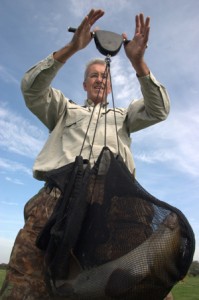 Eventually, even a thick bugger like me has to question the veracity of his scales. So I invited the rest of the DVSG round for a curry night and a chance to run a thorough scales check. What followed was a real eye-opener.
Eventually, even a thick bugger like me has to question the veracity of his scales. So I invited the rest of the DVSG round for a curry night and a chance to run a thorough scales check. What followed was a real eye-opener.
After comparing ten sets of scales it was impossible to establish which, if any, was the definitive, accurate set. It also emerged that a set of scales might be accurate at one weight and inaccurate at another. But I’m racing to conclusions. Let’s look at how we undertook the comparison tests.
In my garage, string was hung from a roof joist. Each set of scales could then be looped up and any vibration or human error eliminated. The scales were set at zero before a large weigh sling was placed over the scales’ hook. Four different weight ranges were tested to represent the target weights of species we might catch. For example, a can of Dynamite hemp plus the sling weighed around 2lb 12oz whereas a jar of the same was in the region of six-and-a-half pounds. Two jars topped 12lb while four went 24lb, or thereabouts.
Let me make something quite clear at this stage. We were not conducting a comparative test to establish the best brand although some may try to draw that conclusion. The scales used varied significantly in age and condition. The newest were pristine, others were decidedly grubby and I’d like to think they are a fair representation of the scales used by a typical cross-section of anglers, even so, I guess there will be thousands of anglers using scales that are nowhere near as good.
The results proved fascinating and hammered home the importance of a single ounce. As I suspected my own bread and butter scales were seriously out of calibration, under-weighing by something like 19 ounces on a 24lb test. That is simply unacceptable and I’ve since had plenty of time to reflect on the impact this might have had on some of my most memorable catches. Did my best Trent barbel top 15lb? And what of those five big nines in a single night. Imagine, it’s remotely possible that I caught five doubles from one swim in the space of around four hours…
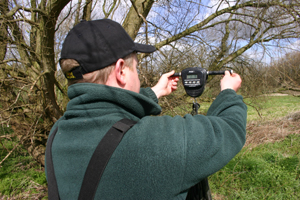 Unfortunately, there’s no rewriting of the history books. My PB list will stand unaltered unless I’m fortunate to catch something bigger. One thing’s for sure if I do it’ll be weighed on a more accurate set of scales.
Unfortunately, there’s no rewriting of the history books. My PB list will stand unaltered unless I’m fortunate to catch something bigger. One thing’s for sure if I do it’ll be weighed on a more accurate set of scales.
Anyway, back to the results. After discounting the wayward weights a mean was established from the remainder. I’m sure a professional data analyst could manipulate the figures and interpret them quite differently. However I simply calculated a mean weight by averaging and then applied an error tolerance target of approximately one percent.
There are so many variances that can come into the actual weighing process of a lively, wet fish I think we’d all be happy if the pictures published in the press were accurate to within one percent, wouldn’t you agree?
Let’s have a look at the chart, Data 1. As you can see from the results shaded in pale blue, all but eight of the remaining 38 records are accurate within the target tolerance of one percent. However, all 16 of the digital results produce results where the angler loses out.
Figuring that the digital results compared very favourably with each other I produced a second chart, Data 2, in which the Assumed Mean is lowered by an ounce and what a difference that makes. No less than 17 of the 38 valid readings fall outside the one percent tolerance. However, 14 of the 16 digital readings are inside. If this mean is correct then only 7 of the 22 dial readings pass muster.
Expanding on this, anglers using the digital scales lose out in 6 of the 24 weighings while those using dial scales gain (as much as five ounces) in all but one of 22 readings.
What does hit you in the eye is how consistent the digital scales are in the first three categories but every set we tested appears to lose the angler a few ounces in the 24lb category. Either that or the dial scales all exaggerate the weight.
You don’t need me to tell you that a five ounce tail off is the difference between a 19lb 12oz carp and one of 20lb 1oz, a statistic that is extremely important to the vast majority of budding carp and pike anglers.
Of course, if the dials are adding 5 ounces that is just as bad because at the end of the day we are only kidding ourselves if we fluff our weights up a bit.
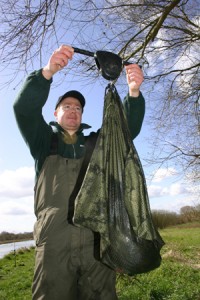 One thing that became patently obvious was that I needed to replace my scales but unless you are able to do some kind of comparison test like this you can have no idea whether your scales are as badly out of calibration as mine are.
One thing that became patently obvious was that I needed to replace my scales but unless you are able to do some kind of comparison test like this you can have no idea whether your scales are as badly out of calibration as mine are.
It also emphasis the need to weigh every fish you catch on the same set of scales otherwise your list of PB’s is meaningless.
So, where does that lead us? Well, you can safely treat every published capture in the angling press with a pinch of salt because I don’t care who the angler is, how honest or how much care they take in weighing their fish, they cannot swear with any degree of certainty that their scales are right so their claimed weights are no more than approximations.
Even if you go to the extreme of having your scales checked by Weights and Measures there’s no guarantee they are accurate when you next go fishing. It may only take a bit of damp, a bash in the car boot, a sudden jerk or a clumsily dropped bag to put them out of calibration.
If we were operating to ISO9002 criteria we’d have to have a schedule for calibration checks, keep precise records and then have to carry comparison weights with which to check the scales before every reading is taken. Sounds mad I know, but I well remember being interrogated by a Lloyds auditor about a 50mm stainless steel block used to calibrate ultrasonic equipment. How could I prove that the block, used to check the measuring probes were set up accurately, wasn’t worn?
We’d also have to guarantee standards of servicing, establish a servicing schedule and a procedure for care, handling and transportation. Chucking them in the bottom of a rucksack simply wouldn’t do.
No, at best our weighings represent fairly accurate guesswork.
But the variables don’t end there. Has anyone considered the air temperature? Does the metal spring in a dial scale behave in exactly the same way in a heatwave as it does when the mercury has slipped below zero? My steel ruler states that it accurate at 20 degrees Celsius. Not at 10 or thirty…
What about humidity?
Does the spring relax after a period of use? Thinking back, my good old Little Sampsons had a nut that could adjust the spring tension if I recall. Or maybe that just altered the zero point, I don’t know.
And then there’s a lesson for those who think that digital scales are the way forward. Ron’s batteries were flat when we tested his and had to be replaced. Imagine fishing alone in the middle of no-where, catching that fish of a lifetime only to find your batteries are flat. The simple solution is never set foot on the bank without a spare set of batteries.
Mind you, does a brand new battery give the same reading as one that is on its last legs? Questions, questions and more questions.
I know with absolute certainty now that some of my most memorable captures have been weighed on dodgy scales to my cost. Other members of the DVSG have caught fish this past year that came so close to the glass ceilings we have created, Mike’s 2lb 15oz roach for instance. Adam and Matt recently had tench of 9lb 14oz and 9lb 15oz respectively, Andy’s 9lb 15oz bream. Who says an ounce here and there doesn’t matter?
Of course it bloody well does!
I wish I knew what the answer is. Perhaps we should do what the Americans do. They don’t worry too much about the weight of a fish, instead they measure from tip of nose to fork of tail. One thing’s for sure, if we did the practise of deliberately targeting spawning fish would reduce and that would be no bad thing.
But, here in Europe we are stuck with a tradition of weighing things. So, I’ll close the debate with a final question. After reading this article are you still confident that your list of PB’s is accurate, or that your scales are?
I think you owe it to yourself to have your scales thoroughly checked immediately.
I’ve now switched from dial scales to the Fox digitals. I know that these will give me a far greater degree of accuracy and I will also insist that all my future PB’s are weighed on this set of scales. At east if they are an ounce out it will be a consistent ounce and I’ll be comparing apples with apples. Never have I been more convinced that a PB recorded on one set of scales cannot be compared with a future fish recorded on a different set.
Buy the best you can afford and look after them.
The following charts show the results from comparisons between the ten sets of weighing scales and what changing the assumed mean by a single ounce does to the results.
| WEIGHTY MATTERS – THE SCALES OF JUSTICE… | ||||||||||||||||||||||||||||||||||||||||||||||||||||||||||||||||||||||||||||||||
| Scales comparison undertaken by DVSG members on 6th June 2006 | ||||||||||||||||||||||||||||||||||||||||||||||||||||||||||||||||||||||||||||||||
| ROACH/ PERCH | Error | CHUB | Error | BARBEL | Error | PIKE/ CARP | Error | |||||||||||||||||||||||||||||||||||||||||||||||||||||||||||||||||||||||||
| (Weigh sling plus one can of hemp) | (Weigh sling plus one jar of hemp) | (Weigh sling plus two jars of hemp) | (Weigh sling plus four jars of hemp) | |||||||||||||||||||||||||||||||||||||||||||||||||||||||||||||||||||||||||||||
| Bob’s 32lb x 1oz Avons | 2lb 13oz | +1oz | 6lb 8oz | +1oz | 12lb 7oz | +1oz | 24lb 2.5oz | +2.5oz | ||||||||||||||||||||||||||||||||||||||||||||||||||||||||||||||||||||||||
| Bob’s 30lb x 1oz Waymaster | 2lb 13oz | +1oz | 6lb 7.5oz | +0.5oz | 11lb 14oz | -8oz | 22lb 12.5oz | -19.5oz | ||||||||||||||||||||||||||||||||||||||||||||||||||||||||||||||||||||||||
| Bob’s 56lb x 4oz Waymaster | 2lb 13oz | +1oz | 6lb 6oz | -1oz | 12lb 6oz | 0 | 24lb 2oz | +2oz | ||||||||||||||||||||||||||||||||||||||||||||||||||||||||||||||||||||||||
| Adam’s 60lb x 1oz Ruebens | 2lb 12oz | 0 | 6lb 7oz | 0 | 12lb 7.5oz | +1.5oz | 24lb 1oz | +1oz | ||||||||||||||||||||||||||||||||||||||||||||||||||||||||||||||||||||||||
| Mick’s 60lb x 1oz Ruebens | 2lb 14oz | +2oz | 6lb 11oz | +4oz | 12lb 9oz | +3oz | 24lb 4oz | +4oz | ||||||||||||||||||||||||||||||||||||||||||||||||||||||||||||||||||||||||
| Lee’s 40lb x 1oz Avons | 2lb 13oz | +1oz | 6lb 8oz | +1oz | 12lb 8oz | +2oz | 24lb 3oz | +3oz | ||||||||||||||||||||||||||||||||||||||||||||||||||||||||||||||||||||||||
| Andy’s Fox Digital | 2lb 10oz | -2oz | 6lb 6oz | -1oz | 12lb 5oz | -1oz | 23lb 14oz | -2oz | ||||||||||||||||||||||||||||||||||||||||||||||||||||||||||||||||||||||||
| Trev’s Fox Digital | 2lb 11oz | -1oz | 6lb 6oz | -1oz | 12lb 5oz | -1oz | 23lb 14oz | -2oz | ||||||||||||||||||||||||||||||||||||||||||||||||||||||||||||||||||||||||
| Ron’s Fox Digital | 2lb 11oz | -1oz | 6lb 6oz | -1oz | 12lb 3oz | -3oz | 23lb 10oz | -6oz | ||||||||||||||||||||||||||||||||||||||||||||||||||||||||||||||||||||||||
| Matt’s Fox Digital | 2lb 11oz | -1oz | 6lb 6oz | -1oz | 12lb 5oz | -1oz | 23lb 11oz | -5oz | ||||||||||||||||||||||||||||||||||||||||||||||||||||||||||||||||||||||||
| Note: Results in red omitted from mean calculation due to a clear discrepancy | ||||||||||||||||||||||||||||||||||||||||||||||||||||||||||||||||||||||||||||||||
| Assumed Mean | 2lb 12oz | 6lb 7oz | 12lb 6oz | 24lb 0oz | ||||||||||||||||||||||||||||||||||||||||||||||||||||||||||||||||||||||||||||
| Accuracy Against Mean (Approx 1% tolerance) | Target +/- 1oz | Target +/- 1oz | Target +/- 2oz | Target +/- 3oz | ||||||||||||||||||||||||||||||||||||||||||||||||||||||||||||||||||||||||||||
| Key To Colour Coding | ||||||||||||||||||||||||||||||||||||||||||||||||||||||||||||||||||||||||||||||||
| Matches Assumed Mean | ||||||||||||||||||||||||||||||||||||||||||||||||||||||||||||||||||||||||||||||||
| Within Tollerance | ||||||||||||||||||||||||||||||||||||||||||||||||||||||||||||||||||||||||||||||||
| Outside Tollerance | ||||||||||||||||||||||||||||||||||||||||||||||||||||||||||||||||||||||||||||||||
| Angler Gains | ||||||||||||||||||||||||||||||||||||||||||||||||||||||||||||||||||||||||||||||||
| Angler Loses Out | ||||||||||||||||||||||||||||||||||||||||||||||||||||||||||||||||||||||||||||||||
|
||||||||||||||||||||||||||||||||||||||||||||||||||||||||||||||||||||||||||||||||
| Effect of reducing mean by one ounce: | ||
| ROACH/ PERCH | Error | |
| (Weigh sling plus one can of hemp) | ||
| Bob’s 32lb x 1oz Avons | 2lb 13oz | +2oz |
| Bob’s 30lb x 1oz Waymaster | 2lb 13oz | +2oz |
| Bob’s 56lb x 4oz Waymaster | 2lb 13oz | +2oz |
| Adam’s 60lb x 1oz Ruebens | 2lb 12oz | +1oz |
| Mick’s 60lb x 1oz Ruebens | 2lb 14oz | +3oz |
| Lee’s 40lb x 1oz Avons | 2lb 13oz | +2oz |
| Andy’s Fox Digital | 2lb 10oz | -1oz |
| Trev’s Fox Digital | 2lb 11oz | 0 |
| Ron’s Fox Digital | 2lb 11oz | 0 |
| Matt’s Fox Digital | 2lb 11oz | 0 |
| Assumed Mean | 2lb 11oz | |
| CHUB | Error |
| (Weigh sling plus one jar of hemp) | |
| 6lb 8oz | +2oz |
| 6lb 7.5oz | +1.5oz |
| 6lb 6oz | 0 |
| 6lb 7oz | +1oz |
| 6lb 11oz | +5oz |
| 6lb 8oz | +2oz |
| 6lb 6oz | 0 |
| 6lb 6oz | 0 |
| 6lb 6oz | 0 |
| 6lb 6oz | 0 |
| 6lb 6oz | |
| Target +/- 1oz |
| BARBEL | Error |
| (Weigh sling plus two jars of hemp) | |
| 12lb 7oz | +2oz |
| 11lb 14oz | -9oz |
| 12lb 6oz | +1oz |
| 12lb 7.5oz | +2.5oz |
| 12lb 9oz | +4oz |
| 12lb 8oz | +3oz |
| 12lb 5oz | 0 |
| 12lb 5oz | 0 |
| 12lb 3oz | -2oz |
| 12lb 5oz | 0 |
| Note: Results in red omitted from mean calculation due to a clear discrepancy | |
| 12lb 5oz | |
| PIKE/ CARP | Error |
| (Weigh sling plus four jars of hemp) | |
| 24lb 2.5oz | +3.5oz |
| 22lb 12.5oz | -18.5oz |
| 24lb 2oz | +3oz |
| 24lb 1oz | +2oz |
| 24lb 4oz | +5oz |
| 24lb 3oz | +4oz |
| 23lb 14oz | -1oz |
| 23lb 14oz | -1oz |
| 23lb 10oz | -5oz |
| 23lb 11oz | -4oz |
| 23lb 15oz |
A Simple Guide To Weighing Fish
Of course, none of this matters if you don’t weigh your fish properly in the first place. Here’s my ‘how to’ guide to weighing fish. Because barbel fishing is flavour of the month and barbel care a hot topic, Matt Brown and I nipped down to the Dove and caught a fish deliberately for the purpose of shooting this sequence.
Step One
You’ve chosen a swim that looks as if it might produce a barbel. You’ve introduced some bait, left it alone for a fair while and are thinking about making your first cast. STOP! Are you prepared for what follows if you happen to catch a good fish? Lay out the unhooking mat, the one pictured is a Fox Specialist Mat, have the scales handy, forceps and take your sling to the water with you.
Step Two
Okay, you’ve just landed a nice barbel and wish to weigh it. Take your time. Relax. Leave the fish in the landing net, just make sure it is in a bit of flow, facing upstream and that the fish is completely submerged. Let it recover from the shock of eing hooked and the strenuous fight that gave you so much pleasure. Don’t be in too big a hurry to recast. Indeed, resting the swim now is probably a good idea.
Step Three
If you have a friend with you, get him or her to hold onto the net while you wet the weigh sling and zero the scales. Failing that, wet it yourself, and carry it and the fish, in the landing net, to the unhooking mat.
Step Four
Use the sling to wet the mat before placing the fish on it, especially on sunny days. Lay the fish, still in the net, onto the mat and cover the fishes eyes with the mesh. This will help to keep it quiet and prevent it from struggling unnecessarily. Now zero the scales.
Step Five
Lift the fish, lay out the sling and place the net back down on top of the sling. It is now a relatively easy job to slide the fish from the net into the sling.
Step Six
Hook the sling onto the scales and gently lift the fish until the sling is clear of the ground. You don’t need to lift it 5 feet off the floor, just clear of the mat and any vegetation is fine. Don’t hold the dial itself and don’t let the sling touch anything. Check the weight and you’re done. You’ll see I’m using the Fox Shake’n’Dry Barbel Sling which is perfect for dealing with barbel. The handles mean I can carry the fish safely back to the water.
Step Seven
Most people who’ve bothered to weigh a fish will probably want to take a photograph of it. Doing this over the mat is best unless you want to get clever like me and Matt did in this sequence and take the trophy shots actually in the river. That way if the fish was to struggle it could come to no harm.
Step Eight
Let the fish recover fully in a good strong flow before releasing it. You can do it in the sling if you like or you can nurse it. I like to do both, sling first and then hold her facing upstream. She’ll tell me when she’s ready to go but I’ll still watch her like a hawk. Only when I’m certainthat she’s fully recovered will I recast.
Ten Top Tips
1. Prepare everything ready in advance – and that means BEFORE you catch the fish.
2. Please don’t weigh every fish just for the sake of it.
3. Clip your forceps on the mat straps. That way you don’t waste time having to look for them.
4. Place the mat on level ground, rushes, etc. This will stop the fish from sliding about.
5. Whenever you can, get a mate to help out.
6. Place a hand over the fishes flank while you mess around in case it thrashes about.
7. If you have to take your hand away, cover the fishes eyes with the net’s mesh
8. Take care not to kneel on your rod in all the excitement.
9. Be as quick as you can but don’t rush or panic. Operate smoothly and efficiently.
10. Never be in a great hurry to recast. The swim will benefit from a rest.
